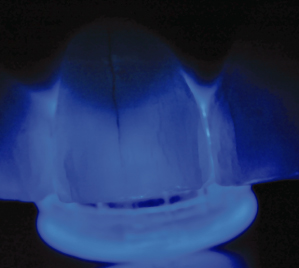29
Crown Fractures in Permanent Teeth
Infractions
An infraction represents a crack in the enamel without the loss of any tooth structure. It is best diagnosed with the use of transillumination (Fig. 29.1), shining a high-intensity light from the palatal surface of tooth. There is a low risk of subsequent pulp necrosis independent of any other injuries such as luxation.
Figure 29.1 Transillumination to observe cracks and infractions in the enamel following trauma.

Management
- Pulp sensibility test at presentation.
- Periapical radiograph.
- Warn parents and child about the risk of pulp necrosis.
- Review at 3 months and then 12 months.
Pulp Sensibility Tests
Children will often give false responses to pulp sensibility testing especially early after a traumatic event. Furthermore, they may respond to the pressure of the test rather than the sensation of cold or electrical stimulation. Recently traumatised teeth will often fail to respond normally initially after the injury but this should not be taken to indicate pulp necrosis.
- Begin testing on a normal tooth.
- Cold tests are usually easier to interpret in younger children than electrical tests.
- Try testing the tooth with pressure first (turn the ice stick around so that there is no cold sensation only the touch).
- Use multiple tests and then test other teeth before returning to the traumatised tooth.
Uncomplicated Fractures
An uncomplicated enamel (class I Ellis) or enamel/dentine (class II Ellis) fracture does not involve the pulp (Fig. 29.2). The aim of management is the preservation of pulp vitality. It is important to remember that recently erupted permanent incisors have wide-open dentinal tubules and there is an increased risk of pulp necrosis as the size of the fracture increases. Generally, there is a low risk of pulp necrosis (∼3.5%), however, with large proximal fractures this may increase to 54% (Ravn, 1981). Protective coverage of the dentine may reduce this risk to 8%. Good practice, therefore, dictates that children suffering these injuries should be seen as early as possible and any exposed dentine cover/>
Stay updated, free dental videos. Join our Telegram channel

VIDEdental - Online dental courses


